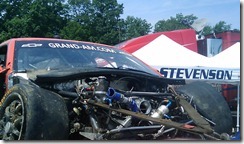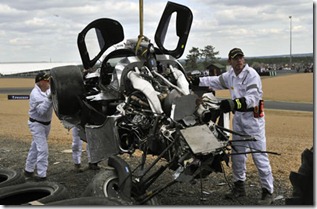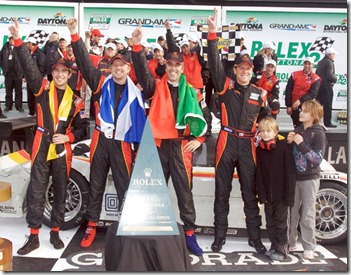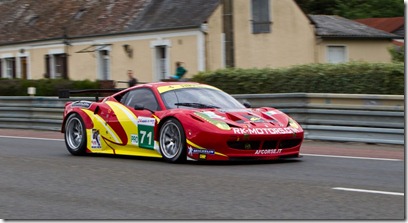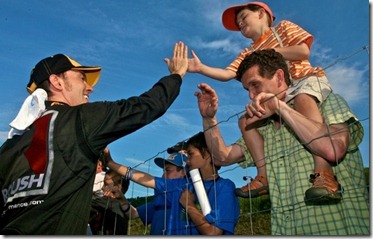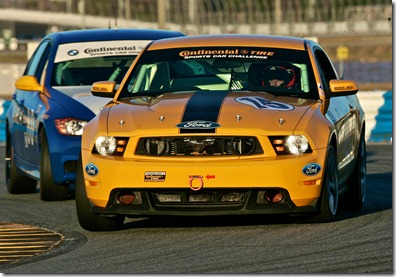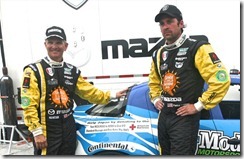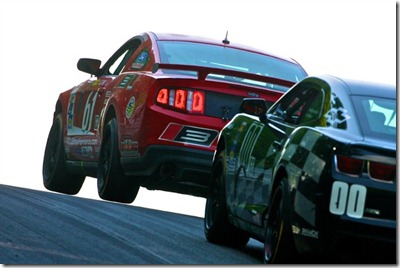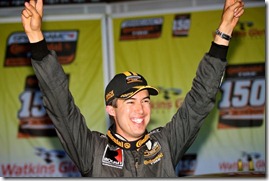SANDBAGGING?
The world of racing is such an odd one.
When the boys in white-and-blue, otherwise known as the No. 01 TELMEX BMW-Riley (by the way, Carlos, we know you’re still in your honeymoon phase and all, but, gee, when is your bride gonna let you come to the track again?) ran the fist-of-year Rolex Series’ pool table, people started raising such a ruckus that the car was ordered to NASCAR’s research center and subjected to a cavity search that’d make the folks at TSA proud while, just like most TSA searches, illegal devices were absent from the TELMEX car, too.
Then, just when everyone had accepted that the TELMEX car would simply win the rest of the 2011 race schedule without challenge, the team produces seventh and second-place finishes, respectively compiled at Lime Rock Park and Sahlen’s Six Hours At The Glen.
So, what’d folks say?
“Sandbagging!”
Well, TELMEX team manager (is he a “director” yet?) Tim Keene then just suddenly breaks with TELMEX’s two-race “tradition” and oversees a win at Road America.
So there!
Then again, traveling a little farther down the “untouchable” path was the an apparent end of a budding end-of-year, three-team championship thrash – a la the 2007 Miller Motorsports Park race – at the EMCO Gears Classic at the new and now constantly improving Mid-Ohio Sports Car Course.
It’s pretty clear the EMCO folks would dread a year-ending September 16-17 Mid-Ohio show devoid of championship-chase thrills – just like the rest of us.
THE BEAT GOES ON
The late Sonny Bono for years looked like a guy who just couldn’t ever believe he’d actually been lucky enough to “score” Cher.
Sonny actually later proved a little deeper – eventually becoming a member of the U.S. House of Representatives as well as being an astute businessman – but over the roughly 13 years they were an “item” Sonny looked nothing less than stunned.
Well, Ol’ DC probably would’ve been stunned, too. In fact, Cher’s still stunning just from “here.”
Unlike Sonny, Jon Fogarty and Alex Gurney looked fairly satisfied (engineer, race-strategist Kyle Brannan being the stunned one) the podium is beginning to feel like home again for their Bob Stallings’ No. 99 GAINSCO Chevrolet-Riley after Saturday’s second-place Road America VisitFlorida.com race finish.
For “The Dragon” the last three races now have produced a 4-3-2 countdown to “one” – and where better than “home” in fewer than two weeks (Saturday, June 9) at Mazda Raceway Laguna Seca?
For Fogarty and Gurney, the “secret” to their improvement has been the ability to test, evidently absent for the better part of the season’s first half.
PROOF POSITIVE
Motorsports journalist John Dagys got one of the season’s best, um, “aftermath” photographs of Gunter Schaldach’s motionless CoolTV Camaro, which at Road America made like an Ornimegalonyx and succeeded. Well, after it tried to air it out, that is.
In the last 35-minutes, Ol’ DC has seen the otherwise “flightless” Camaro no fewer than nine times – count ‘em; nine times.
IT JUST MADE SENSE
“The cars were at such a good price, it just made sense” not to add insult or injury, staying instead with the engines they brung, insisted DP team owner Peter Baron in explaining how one of his two cars went from a deep-throated Ford to emitting a slightly higher pitch with a flat-six Porsche in the No. 2 Starworks’ Avior Riley engine bay of Venezuelan drivers Alex Popow and Enzo Potolicchio.
Satisfied with taking receipt of two finely maintained Penske Racing Daytona Prototypes which, during the 2009 season, were the object of gunshots at the feet (metaphorically speaking, folks) – both self-aimed and found squarely in the crosshairs of others – Baron said it’d cost in the neighborhood of $45,000 each to modify the two former Penske chassis for the Ford engine still carried by the No. 8 of Mike Forest and Ryan Dalziel’s No. 8 Grout Shield Ford Riley, which finished fourth Saturday at Road America’s VisitFlorida.com Rolex Series race.
The No. 2 Starworks Porsche-Riley finished eighth.
FOSTER RELEASED
With little additional news than hearing the concern for Joe Foster’s physical health had more to do with neck, shoulder and/or collar bone injuries than ribs, the No. 40 Patrick Dempsey Racing VisitFlorida.com driver/owner nevertheless was released from Milwaukee’s Froedtert Memorial Lutheran Hospital after being flown there following the Turn 1 row with Gunter Schaldach’s CoolTV Camaro, referenced earlier – and an additional dozen-or-so times on TV since the first mention made above.
Whew, there’s nothing like getting the media churning than an everyday racing crash, huh?
Later,
DC
